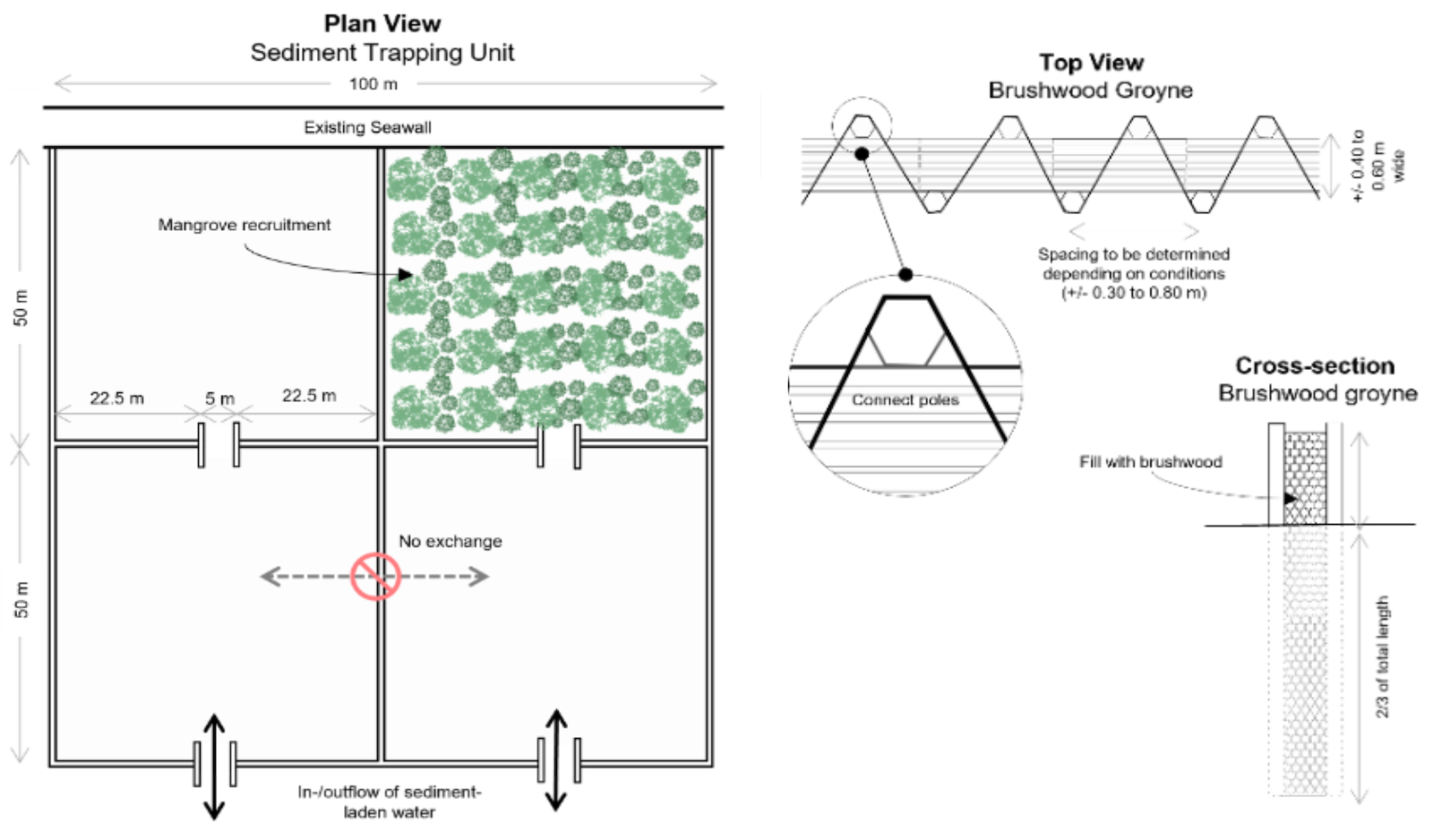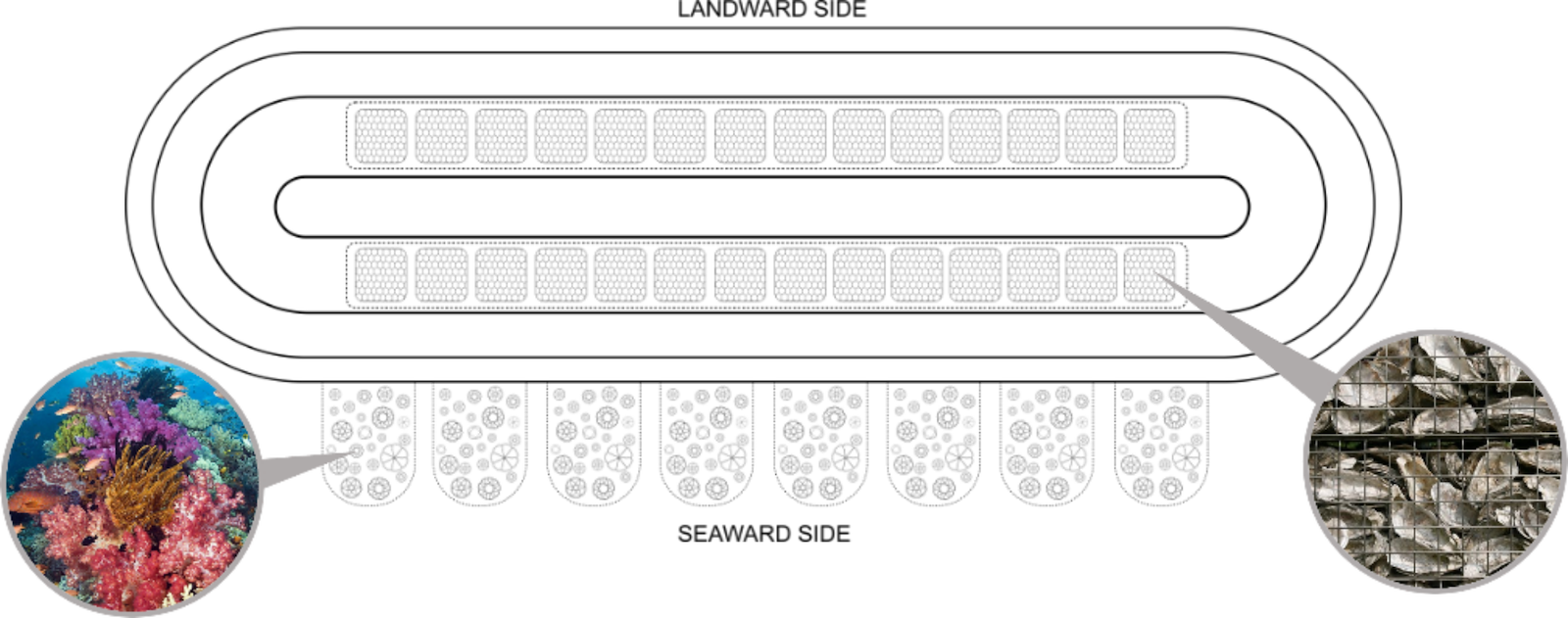Methods
This chapter outlines the general practices for implementing the concept designs presented in the following section. It is important to note that these methods are at a conceptual stage and will require further localization or adaptation through detailed engineering designs. Nonetheless, they serve as a foundation for the detailed design process, as they are based on the NbS principles embodied in this study.
Green Embankment


Traditionally, embankments have been constructed using hard engineering methods, such as concrete or stone. They can be visually unappealing, built only for a single purpose, and may lack ecological functionality. Green embankments, on the other hand, integrate natural materials, vegetation, and sustainable engineering techniques to create resilient and environmentally beneficial structures.
At the core of this conceptual design is the use of vegetation and re-used dredged materials to reinforce the embankments. In the case of the two (2) pilot locations, a surplus of dredged materials from the river can be recycled for this NbS that can minimize costs and wastage of resources. This requires further geotechnical investigations in the detailed stages of the project to ensure suitability of the materials.
In addition, appropriate plant species, selected based on their ability to thrive in the specific conditions of the embankment, are important considerations for the design. The uses of biodegradable erosion/filter systems can be employed such as coconets as illustrated in the figure at the left to further strengthen the embankments. These are used to stabilize the streambanks and permit planting of wetland vegetation within them. The vegetation acts as a living cover, providing root systems that bind the soil together, improving stability and reducing erosion risk.
Green embankments often require gentler slopes compared to their traditional grey counterparts to help promote the establishment of healthy root systems and further enhance soil stability for the re-used dredge materials. Slopes are recommended to be no steeper than 1:4, generally aiming for 1:6, to facilitate maintenance and ensure public safety. A crest of five (5) meters minimum is recommended for futureproofing in case additional embankment height is needed to adapt for additional flood protection.
Sediment Trapping

Sediment Trapping Units (STUs) are composed of indigenous materials such as bamboo and brushwood and mainly facilitates the restoration of tidal flats and contribute to the increased survival of mangrove recruitment. Currently, the residents of Barangay Pamarawan are actively engaged in community-led mangrove reforestation efforts. However, the success of these initiatives has been hindered by the strong waves washing out the seedlings before maturity. Another approach to consider involves mangrove nurseries (outside of the coastal zone) to grow the seedlings before planting them. During the early stages of mangrove development, the STUs provide necessary protection until the mangroves are mature enough to take over.
As illustrated in the figure below, it is recommended to construct five (5)-meter openings approximately every 25 meters in the fences to allow sediment-laden water to enter. Both stand-alone and neighbouring STUs should have side walls to ensure even distribution of sediment deposition. The frontal fence, facing incoming waves, may be constructed using double fences, while single fences are generally sufficient for the side walls if properly maintained. Once the mudflat heights have reached a sufficient level and mangrove recruitment is well established, a new series of STUs can be constructed in front of the previous series.
Nevertheless, these structures are still prone to degradation due to the natural materials used and thus require regular inspection and maintenance. Design factors for land subsidence must also be considered to avoid future setbacks. As mangroves develop into a broader greenbelt, ideally around 500 meters wide, storm surges can be effectively mitigated reducing damages from wave impacts in coastal communities.

Enhanced Breakwaters

In contrast to conventional breakwaters, enhanced breakwaters as illustrated in the figure to the left are designed to consider ecological functions while fulfilling their role as coastal defence structures. Primarily, these breakwaters are proposed mainly to mitigate the impacts of storm surges in barangay Pamarawan, a significant contributor to coastal flooding in the area. In addition, the key element of this Nature based Solution is the inclusion of oyster reef restoration, which is also a significant source of livelihood for the local fisherfolk in the barangay. During the site visits, it was observed that residents collect empty oyster shells which can be used as suitable substrates for the recruitment of young oysters through the process known as spat-on-shell culturing. These shells, with young oysters attached, can be integrated into the design of the enhanced offshore breakwaters to facilitate the restoration of oyster reefs.
Furthermore, insights gained from the Eastern Scheldt shellfish reefs for shoreline protection, confirm and demonstrate that iron wire cages or gabions filled with deceased oyster shells can develop into thriving, sustainable reefs. Artificial oyster reefs can also provide the critical hard substrate for coral restoration which then enhances habitat space for marine life. By incorporating similar principles in the design of the enhanced breakwaters, this Nature based Solution can cultivate local livelihood and foster biodiversity while also providing a first line of defence against coastal flooding and erosion.
The design and placement of these enhanced breakwaters must be carefully considered to maximize its success in reducing erosion and wave energy. Furthermore, it is important to anticipate potential alterations to sediment transport patterns and coastal morphology over time. Factors such as depth, width, height, slope, and positioning relative to the shoreline play crucial roles in determining the overall effectiveness of the structure.
